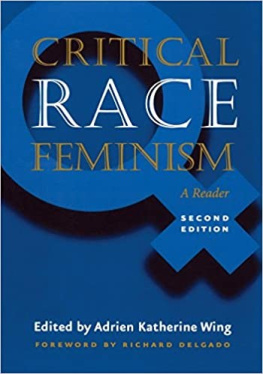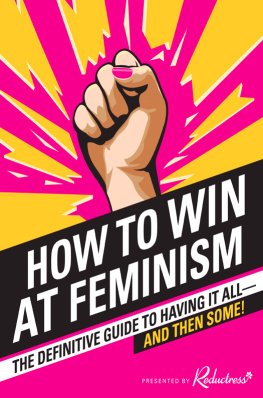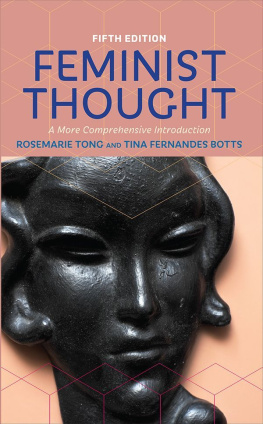Table of Contents
To my friend and former student,
Roxana Rivera (1977-2003)
PROLOGUE
IN HER BOOK THE COLOR OF JEWS Melanie Kaye/Kantrowitz shares an anecdote that I find particularly helpful in explaining why a book about women of color should be essential reading for everyone. Regularly teaching courses on topics such as racism, poverty, and anti-Semitism, she describes the inevitable moment when a student who has grown weary of discussing these issues raises her hand and asks, Cant we just be people? Kaye/Kantrowitzs response is blunt: Thats what racism [or any other oppression] costs you.... You dont get to just be a person. What she means is that social injusticewhether we cause it, are hurt by it, or happen to benefit from its effectsdehumanizes all of us. Our constructed identities serve only to protect us from or expose us to oppression in different ways. Saying we do not support racism or sexism does not absolve us from the harm that these discriminations cause others. In fact, unless we actively disrupt the system daily and in radical ways, we can all become accomplices to oppression. Consequently, whether we choose to recognize it or not, at different times all of us give up the right to be considered just people as long as social injustice and inequality prevail. In the meantime, we must get in line with everyone else and pick up the baggage that comes with the category or identity that we have (usually unconsciously) agreed to assume.
In my own discussions with students, I like to tell them that no one leaps out of the womb claiming to be an oppressor. Yet from the moment we are born, opportunities and disadvantages are laid out based on our race/ethnicity, gender, class, and sexuality. When we choose not to critically analyze who we are or the paths that have gotten us to where we are today, we become less than whole. In particular, we relinquish part of our humanity because this process dissociates us from other human beings. We learn to forget that our actions are tied to the lives of others. In turn, others grow up suspicious of us because of what they learn to associate with the identities that we take on. As Kaye/Kantrowitz aptly puts it, Mistrust poisons the air.
If you do not identify as a woman of color, you might not initially see the point of picking up this book, but I urge you to read on. If you are a woman of color, I ask you to consider how your life histories are interconnected with someone elses. How much do any of us really know about each others cultural pasts? In a wonderful essay about storytelling and the origins of our world, John Edgar Wideman writes, Suddenly, the mist cleared. Below the people, the earth had changed. It had grown into the shape of the stories theyd tolda shape as wondrous and new and real as the words theyd spoken. But it was also a world unfinished, because not all the stories had been told. This is how I imagine that learning about the lives and experiences of women of color can change everyones world and improve our individual lives. We have stories to hear that will in turn prompt us to share our own. We have stories to revisit because some aspects were previously left out. We have stories to go back and find before they are permanently lost, and we have stories we altogether need to forget. In short, we have a lot of talking and sharing to do.
This exchange can take place, however, only when we switch up the standard order in which we are used to receiving information. Its what we in academia tend to call decentering. The centers of our societythe dominant stories that our culture tellsare so embedded in our minds that we take them as absolutes and have a hard time thinking around them without some external push to remind us that when we shift our perspective, we gain a whole new set of insights. In fact, amassing as much knowledge as we can about the world (and subsequently ourselves) should be ultimately one of our lifetime goals. It moves us toward wholeness, toward enlightenment. While we may never get there completely, it is the process of trying that becomes our self-realization.
Part of the project of feminism has been to put womens stories at the center, to understand the world through the perspective of women. But often the generic women has meant white women. Consequently, feminism has not always been embraced by women of color, even those who in all other ways are already politicized individuals. As the chapters of this book will illustrate, there are many reasons for this alienation. I believe that this disjuncture is not irreparable; however, it does require some pause.
Every day it seems I am confronted with the dilemma of whether or not to publicly acknowledge that I am a feminist. The choice would appear easy enough given that I teach in a womens studies department. However, as a Latina from a working-class background whose family and friends are still largely removed from the academic world, I often feel the tension that the word raises when it is brought up. Truthfully, it can be difficult enough just admitting I have a doctorate. When I share this struggle with my students, most of them readily confess to the same problem. Attending a highly diverse, working-class commuter campus, many of them are the first in their families to attend college. Or they are returning to school and have families at home that demand much of their attention. The intellectual work that they do at school frequently does not have a place in their lives outside of the campus. To introduce labels such as feminist into their day-to-day conversations, several admit, is just asking for trouble.
Similarly, the concept women of color is also one that raises questions for people. Most of my female students do not walk in thinking of themselves as women of color even though many identify as being part of a certain ethnicity, such as Peruvian or Vietnamese. Others tend to adopt a broader term such as Latina or African American. Again, there are several reasons why this may be the case, some of which are addressed in subsequent chapters. However, it is worth recognizing the general lack of exposure that peopleeven studentshave to the term before entering a class such as mine. They initially share the same blank look I get whenever I mention the term woman of color to someone in passing. Why is this term not used more widely, at leastwithin the university system? The blank looks I receive when I use the term appear to point perhaps to the greater lack of attention given to the experiences and lives of women of color.
Literary scholar Rachel Lee argues that the marginalization of women of color within the field of womens studies and the greater university structure is at least partially to blame. She describes how at her university the only course to collectively address women of color is set up to meet diversity requirements both within and outside the womens studies major. Thus, it attracts students who have never been exposed to the issues raised, and it can leave them feeling as though the course is only a tacked-on attempt at political correctness and fulfills all that they will ever need to know about this subject matter. Students can then continue with the rest of their educations without ever returning to the issues addressed in the course.
Similarly, a singular course on women of color can marginalize the person teaching it. In particular, it depends on the instructors physical body to authenticate the course (and the department and university), as Lee argues. Ironically, she also notes, this process can distort the instructors actual identity with a constructed one. Instead of being a Latina scholar of American literature (as I am) or an Asian American woman, an interpreter of literature, or even a professor of Womens Studies (as Lee describes herself), as professors who happen to be women of color, we are sometimes thrust into the role of teaching classes on women of color simply because of our perceived identities.








